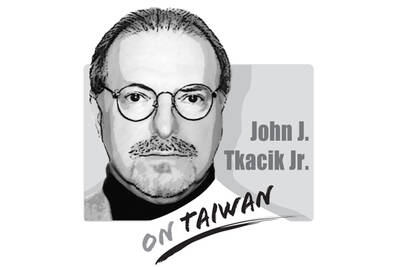A Bloomberg article last week about the loss of Taiwanese jobs to China has drawn mixed reactions. The article attributed the losses to the nation’s sluggish easing of investment rules and slow development of the service industry, saying these have caused Taiwan to fall behind Singapore and Hong Kong.
Some sources attributed job erosion to the government’s China policies, which they said helped domestic manufacturers relocate to China in the shortest time possible without creating jobs at home. Others said Taiwan was facing a labor shortage, rather than high unemployment, with the nation’s unemployment rate falling to 4.27 percent in May, its lowest level in 33 months, after peaking at 6.13 percent in August 2009.
One thing is clear: It is impossible to say that the nation’s unemployment problems have been solved, because the unemployment rate is still higher than pre-financial crisis levels.
An unemployment rate of 4.27 percent is indeed an improvement over one of 6.13 percent, but the government should not paint a rosy picture based on that number alone.
The public should keep in mind that the government’s definition of “unemployment” refers to people who are out of work, but ready to find jobs any time soon. “Discouraged workers,” who are not currently looking for jobs after having tried for a long time, and “non-typical workers,” such as part-time and temporary workers, however, do not fall into the government’s narrow definition of unemployment.
If the roughly 155,000 “discouraged workers” in May are added to the pool of 476,000 unemployed people for that month, the unemployment rate shoots up to 5.66 percent rather than the 4.27 percent reported by the government. In other words, just because certain people do not appear in the official unemployment statistics does not mean the labor market is improving.
Meanwhile, the nation is facing a serious problem of “structural unemployment,” an issue that Mark Williams, an economist at Capital Economics Ltd in London, rightfully pointed out in the Bloomberg article. Indeed, economists have long said that increasing structural unemployment is the main reason for rising unemployment and wage stagnation in Taiwan.
Over the past two decades, many labor-intensive manufacturers left Taiwan for other countries, causing the nation’s economy to go through structural adjustment as it shifts from traditional, labor-intensive industries to capitalized, technology-intensive industries. However, the labor force that lost jobs as traditional industries left Taiwan has failed to catch up with the nation’s industrial upgrade, with job seekers’ skills falling short of the demands of the new industries. Ironically, this has led to a skilled labor shortage and high unemployment occurring at the same time.
Structural unemployment is dangerous; it becomes more difficult to fix the longer it persists. This is because the longer people are out of work, the harder it is to find employment.
Moreover, structural unemployment not only results in a rising number of discouraged workers and shortage of skilled workers, but also restricts wage growth among salaried employees. This is because new industries lack the work force to sustain growth, while social welfare spending on the unemployed continues to expand, adversely affecting the competitiveness of the nation’s economy as a whole.
No matter what message people take from the Bloomberg article, no one should overlook structural unemployment and its implications for the nation’s economy — the paradox of high unemployment and a serious labor shortage, which we must tackle now.
I have heard people equate the government’s stance on resisting forced unification with China or the conditional reinstatement of the military court system with the rise of the Nazis before World War II. The comparison is absurd. There is no meaningful parallel between the government and Nazi Germany, nor does such a mindset exist within the general public in Taiwan. It is important to remember that the German public bore some responsibility for the horrors of the Holocaust. Post-World War II Germany’s transitional justice efforts were rooted in a national reckoning and introspection. Many Jews were sent to concentration camps not
Deflation in China is persisting, raising growing concerns domestically and internationally. Beijing’s stimulus policies introduced in September last year have largely been short-lived in financial markets and negligible in the real economy. Recent data showing disproportionately low bank loan growth relative to the expansion of the money supply suggest the limited effectiveness of the measures. Many have urged the government to take more decisive action, particularly through fiscal expansion, to avoid a deep deflationary spiral akin to Japan’s experience in the early 1990s. While Beijing’s policy choices remain uncertain, questions abound about the possible endgame for the Chinese economy if no decisive
Actress Michelle Yeoh (楊紫瓊) on March 13 posted an Instagram caption after the opening of Tiffany’s Taipei flagship store two days earlier that read: “Thank you Tiffany for inviting us to Taipei China.” We know that Yeoh knows Taipei is in Taiwan, not China, because the caption was posted following comments she made — in English — in which she said: “Thank you to Tiffany for bringing me to Taipei, because I do love this country very much.” Her remarks and the subsequent Instagram caption were reported in Taiwan, in Chinese and English- language media such as Radio Free Asia, and overseas,

Somehow, US intelligence identified “the Houthis’ top missile guy” and pinpointed his exact location. At 1348 hours (Washington time), March 15, President Trump’s national security advisor Mike Waltz texted, “positive ID of him walking into his girlfriend’s building.” The unsuspecting Romeo entered. High above, the drone monitoring the building registered a flash. When the smoke cleared, Mr. Waltz texted, “…And it’s now collapsed.” RIP. The star-crossed “top missile guy” had been target number one in the now uproarious US Navy bombing campaign on that Sunday against the Yemeni rebels who have been holding the Red Sea hostage since October 19,